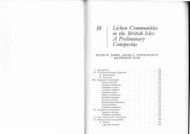You also want an ePaper? Increase the reach of your titles
YUMPU automatically turns print PDFs into web optimized ePapers that Google loves.
habitat (to facilitate determination), date and<br />
collector.<br />
Without any doubt impending in the<br />
consequences <strong>of</strong> the precipitous increase in the<br />
number <strong>of</strong> those interested in lichens is a further<br />
danger to these already richly collected<br />
organisms: is the decimation and extirpation by<br />
lichenologists. In collecting lichens one ought to<br />
consider that many lichens are rare and<br />
endangered. In many cases the collection <strong>of</strong> only<br />
five to ten specimens would have the result <strong>of</strong><br />
extirpation <strong>of</strong> the species in Germany. One<br />
collection <strong>of</strong> rare species is without justification,<br />
especially so, when the lichen already is known<br />
and documented from the region. Occasionally<br />
one can in a certain region collect species<br />
endangered in other regions, where they are still<br />
frequent, without an aggravating result being<br />
“provided.”<br />
A completely removed specimen growns no<br />
longer. The decimation <strong>of</strong> a population can lead<br />
to the endangering <strong>of</strong> the rest <strong>of</strong> the population.<br />
A resettling <strong>of</strong> a species on a locality, on which it<br />
was obliterated, seems in the case <strong>of</strong> rare foliose<br />
and fruticose lichens in many ways extremely<br />
unlikely. This is valid especially for species,<br />
which reproduce with the help <strong>of</strong> relatively heavy<br />
soredia and isidia.<br />
3. Investigations and<br />
Determinations <strong>of</strong> <strong>Lichens</strong><br />
3.1 Introduction<br />
Most foliose and fruticose lichens may be<br />
determined without more than the aid <strong>of</strong> a<br />
handlens, a few without the aid <strong>of</strong> optical<br />
devices. Important are e.g. form and color <strong>of</strong> the<br />
thallus and the fruiting body, occurrence <strong>of</strong> warty<br />
outgrowths (isidia) and “mealy” eruptions<br />
(soralia) and other organs. For the determination<br />
<strong>of</strong> crustose lichens the use <strong>of</strong> a microscope is as a<br />
rule necessary. Indeed the experienced lichen<br />
specialist can easily distinguish almost all lichens<br />
including the crustose lichens by habitat and<br />
ecological characteristics alone, but in<br />
determination one can not commonly by<br />
external characteristics alone, sufficiently<br />
through our grammatical potentiality, be exact<br />
enough about the fine distinctions in coloring and<br />
structures to define them in keys. For this reason<br />
measurable and clearly defined microscopic<br />
characteristics must be applied, e.g. spore form<br />
and size, structure <strong>of</strong> the fruiting body, coloring<br />
<strong>of</strong> the fruiting body parts etc. For the<br />
determination <strong>of</strong> such characteristics sections<br />
through the fruiting body are <strong>of</strong>ten necessary.<br />
The producing <strong>of</strong> sections is not difficult.<br />
They are made much easier, when a binocular or<br />
a dissecting scope is used, under which one can<br />
work with both hands. At least in the larger<br />
fruiting bodies, sections may be prepared without<br />
the aid <strong>of</strong> lenses.<br />
With one hand one holds the lichen fast, with<br />
the other hand one draws an unused razor blade<br />
parallel (vertical) sectioning through the fruiting<br />
body. At best one removes to begin with a<br />
marginal part, perhaps a fourth or a third <strong>of</strong> the<br />
fruiting body and next cuts the thinnest possible<br />
slice, as from a loaf <strong>of</strong> bread, in many lichens the<br />
fruiting body is easily broken loose and then is<br />
more difficult to manipulate. In this case one can<br />
capture the fruiting body with a tweezers or a<br />
preparation needle and glue it to a wooden or<br />
paper support. The section can be accomplished<br />
dry or (above all, in the case <strong>of</strong> hard fruits better)<br />
with objects swollen with water. It can be very<br />
helpful when one holds the object fast with one<br />
finger so that the fingernail is almost at a right<br />
angle and is used as “backdrop” for the razor<br />
blade. The section may be lifted easily from the<br />
object with the (under the circumstances)<br />
moistened edge <strong>of</strong> the razor blade or with the<br />
point <strong>of</strong> a preparation needle. It is then placed in<br />
a small water drop on the slide and covered with<br />
a cover glass. If the section is not thin enough,<br />
one may squash it somewhat. For which one<br />
places the slide with the cover glass beneath<br />
upon a page <strong>of</strong> filterpaper and presses.<br />
A considerable aid in determination is <strong>of</strong>fered<br />
by color reactions <strong>of</strong> the lichen thallus with<br />
designated chemicals. Many lichens contain the<br />
same substances, which with these substances<br />
yield colored reaction products. The most<br />
important reagents are calcium hydroxide<br />
(KOH), calcium or sodium hypochlorite<br />
(Ca(OCl)2 / NaOCl2) and para-Phenyldediamin<br />
(H2NC6H4NH2). The procurement <strong>of</strong> reagents<br />
becomes increasingly more difficult. Chemical<br />
handling comes into question, under<br />
circumstances even for apothecaries and<br />
druggists. Druggists <strong>of</strong> commercial chains<br />
today do not accept individual orders.<br />
3.2 Important Diagnostic Characteristics<br />
<strong>of</strong> <strong>Lichens</strong><br />
3.2.1 Color <strong>of</strong> the Thallus<br />
8





